Over the past few years, AI-driven coding software has evolved from experimental helpers into essential parts of the developer’s toolkit. While human expertise remains critical, AI now plays a much more active role in writing, reviewing, and optimizing code. Sam Babic, the Chief Technical Adviser at US-based Hyland Software Inc., described these solutions as a "second set of eyes," offering a fresh perspective and valuable assistance in programming.
This article will define AI coding, explore its main benefits and features, and evaluate five notable AI coding tools.
What is AI coding?
AI coding refers to using artificial intelligence to assist developers in writing and reviewing their code with the ultimate aim of enhancing code quality and boosting productivity. It is one of the many innovations present in AI-driven software development workflows.
This practice is rapidly gaining popularity, as evidenced by a GitHub survey revealing that 92 percent of U.S.-based developers already leverage AI coding tools both in and out of work.
Artificial intelligence coding technologies
For a clearer understanding, it's essential to grasp the main interconnected technologies driving AI coding.
Natural language processing (NLP) is a branch of AI that makes machines capable of comprehending human language. It harnesses linguistic principles, statistics, and machine learning algorithms to interpret spoken or written language, going beyond literal interpretations to capture context nuances. With NLP, computers can discern a person's intent and analyze expressed sentiments, much like human perception.
Read our guide to Natural Language Processing, to learn more about NLP use cases, tools, and approaches.
Deep learning, a subfield of machine learning, leverages artificial neural networks that excel in analyzing large volumes of data. Deep learning is capable of handling intricate and complex tasks like speech recognition and image recognition. AI coding tools utilize deep learning models trained on extensive datasets of source code, often derived from open-source projects.
Learn more from our dedicated article on deep learning and the future of artificial intelligence.
Generative AI is, in turn, a subset of deep learning. It relies on unsupervised and semi-supervised learning techniques to build sophisticated AI models that can produce new content based on existing text, images, audio files, or, in our case, code. The idea is to create original works undistinguishable from those produced by a human.
If you want more details, read our article about generative AI models or watch a video, explaining their value to business.
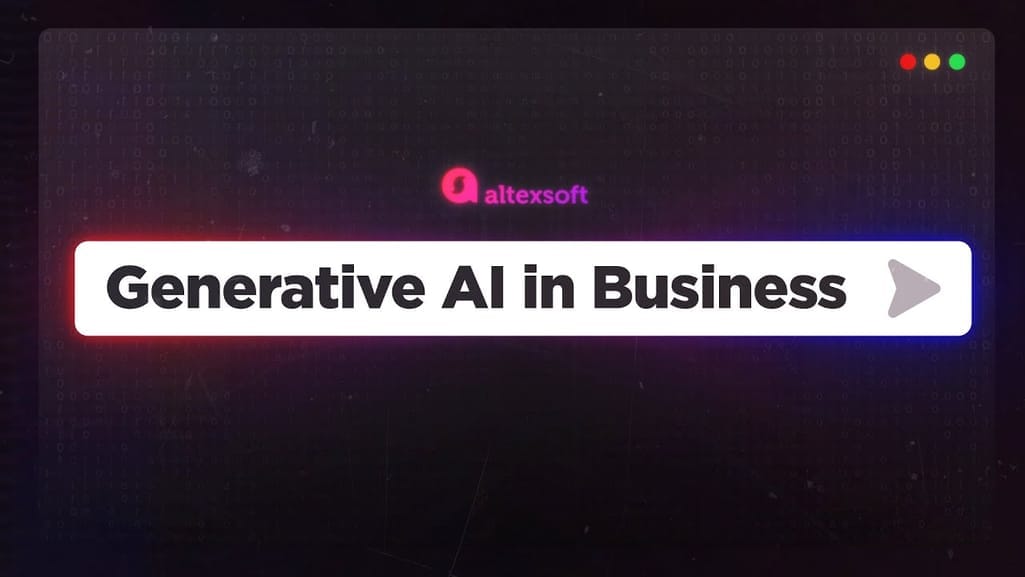
Five use cases of generative AI in business.
Large language models (LLMs) represent a subset of generative AI models with the primary function of predicting the next most suitable word to fill in a blank space in given text based on the context. LLMs are trained on large collections of text data and can be applied to a range of NLP tasks.
For a deeper understanding, read our article to learn more about language models and how they work. Another article explores a practical topic: LLM API integrations for building different AI instruments, including AI coding tools.
We also recommend checking out the article that comprehensively explains the difference between data science, machine learning, AI, deep learning, and data mining.
The benefits of AI coding
With AI coding tools on the rise, let's explore their primary advantages.
Boosted productivity. AI coding tools can significantly increase productivity and accelerate code development. They save time by automating repetitive tasks like code formatting and boilerplate code generation. In addition, coding tools with generative AI can provide valuable code suggestions, helping developers overcome writer's block and jump-start the first draft of the new code.
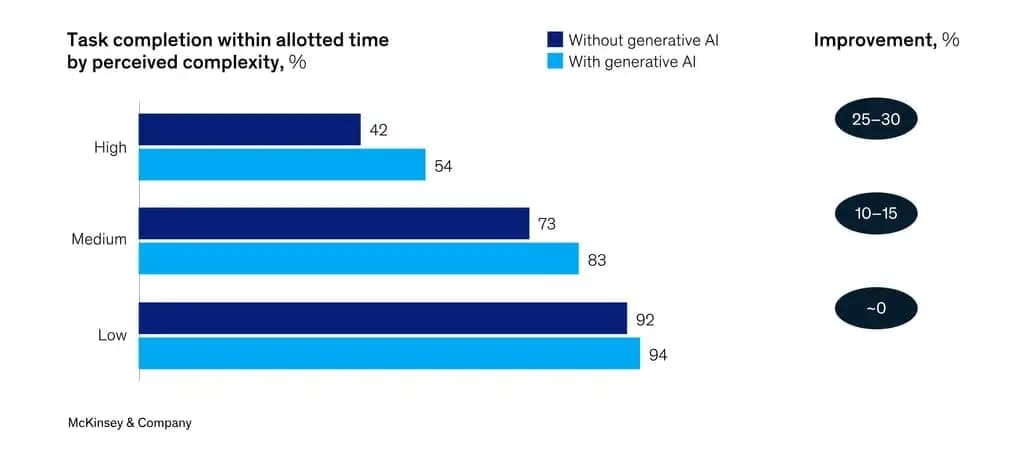
The graph illustrates the improvement in task completion efficiency when using generative AI compared to task completion without generative AI. Source: McKinsey Digital
In a study by McKinsey Digital, developers were assigned tasks of varying complexity with specific time constraints. The results showed that participants using generative AI were more likely to meet deadlines compared to those who didn't apply such tools. In fact, the research revealed that generative AI is especially efficient for tasks of higher complexity, improving productivity by 25 to 30 percent.
Improved code quality. AI coding tools enhance code accuracy by providing real-time suggestions based on industry best practices, identifying issues, alerting on potential bugs or security vulnerabilities, and, in general, acting as a safeguard against common coding mistakes. This helps developers create cleaner and more error-free code.
Empowering non-developers and newcomers. AI coding tools make code development more accessible to non-developers and newcomers. These solutions simplify programming and facilitate the learning curve by giving contextual guidance and responding to natural language comments. They can serve as mentors, breaking down complex concepts and providing step-by-step instructions. In essence, AI coding tools offer comprehensive assistance for non-developers and foster a supportive learning environment for newcomers.
AI coding tools features
In this section, we present the most common features of AI coding tools, exploring the diverse ways in which AI can contribute to optimizing the development process. Apart from the functionality mentioned here, some AI coding tools are also capable of code refactoring, code documentation, providing explanations, and searching for certain files and code snippets.
Code completion
AI code completion involves suggesting code snippets as developers type by predicting the next code that is likely to be written based on the context. This reduces manual input, enhances code consistency, and minimizes errors, which is especially valuable for repetitive tasks.
Code generation
AI code generation is a process that transforms natural language prompts describing the desired functionality into executable code. It comprehends the provided suggestions and then offers contextually relevant code, considering established programming patterns.
Read our articles on how to engineer prompts to get the best results with generative AI and on the role of prompt engineer.
Code translation
Code translation refers to converting the source code into the desired programming language. It allows you to seamlessly integrate code from different teams within the organization or other open-source projects. It can also reduce the effort and expense of updating legacy codebases written in ancient programming languages like COBOL or Ada.
Code review
Code review is an evaluation process that harnesses the power of AI to increase code quality by identifying and fixing errors. AI coding tools can also generate comments and explanations in natural language. This makes it much easier to understand the review process, which is particularly beneficial for developers seeking detailed feedback to improve their coding skills.
Agent AI
Agent AI is a new generation of AI behavior where an artificial assistant can autonomously plan and execute multi-step tasks with minimal human intervention. Instead of responding to each prompt separately, agentic AI models can understand the overall goal, break it into smaller tasks, and execute them or propose a plan for human approval.
Many AI coding editors offer agentic mode (in the form of a chat), together with the traditional prompt-driven assistance. In addition to writing code, an agent AI can interact with internal and external data—for example, access a file system to read or edit files, run code in a sandbox, query a database, etc.
Read our article about AI agents for a deep dive into their capabilities and real-world use cases.
Best AI coding tools compared
Here, we provide an assessment of five widely used AI coding tools, considering critical factors that influence their suitability for particular needs. We compared them based on essential criteria such as language support, integrations, functionality, and pricing.
Since publicly available sources are primarily in English, AI coding tools will likely work worse when prompts are written in other languages or contain grammatical errors.
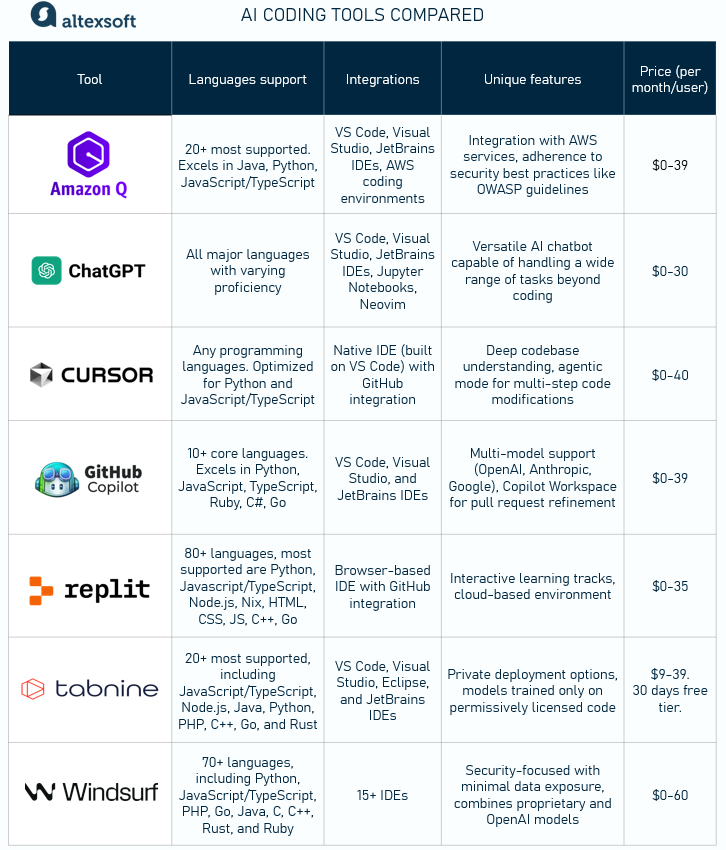
A general overview of seven AI coding tools.
GitHub Copilot: Trained on all programming languages and masters various coding tasks
GitHub Copilot is an AI pair programmer, meaning that it serves as a coding partner for developers, collaborating with them in real time. It is powered by a generative AI model developed by GitHub, OpenAI, and Microsoft. You can also select different LLMs, like Claude 3.7 Sonnet, OpenAI o1, and Google Gemini 2.0, to ask for suggestions.
Language support. GitHub Copilot has been trained on all programming languages found in public repositories. Yet, the quality of suggestions can vary based on the volume and diversity of training data for a particular language. Keep in mind that the tool works best for Python, JavaScript, TypeScript, Ruby, C#, and Go.
Integrations. GitHub Copilot works as an extension of Visual Studio (VS) Code, Visual Studio, and the JetBrains suite of IDEs.
Functionality. GitHub Copilot offers autocomplete-style suggestions tailored to the project's context. It analyzes the code written before the cursor, the context of the file being edited, and related files.
The tool has a chat interface called GitHub Copilot Chat that lets users ask coding-related questions and receive responses directly within a supported IDE. Copilot Chat can help with a variety of coding tasks by suggesting code snippets, providing natural language descriptions of code's functionality and purpose, generating unit test cases, analyzing code for potential vulnerabilities, and proposing fixes based on the context of the errors.
In April 2025, Copilot rolled out agent mode, so far only in Visual Studio Code, with future plans for all IDEs. It helps developers with a variety of tasks, from autofixing code gen errors to building web apps.
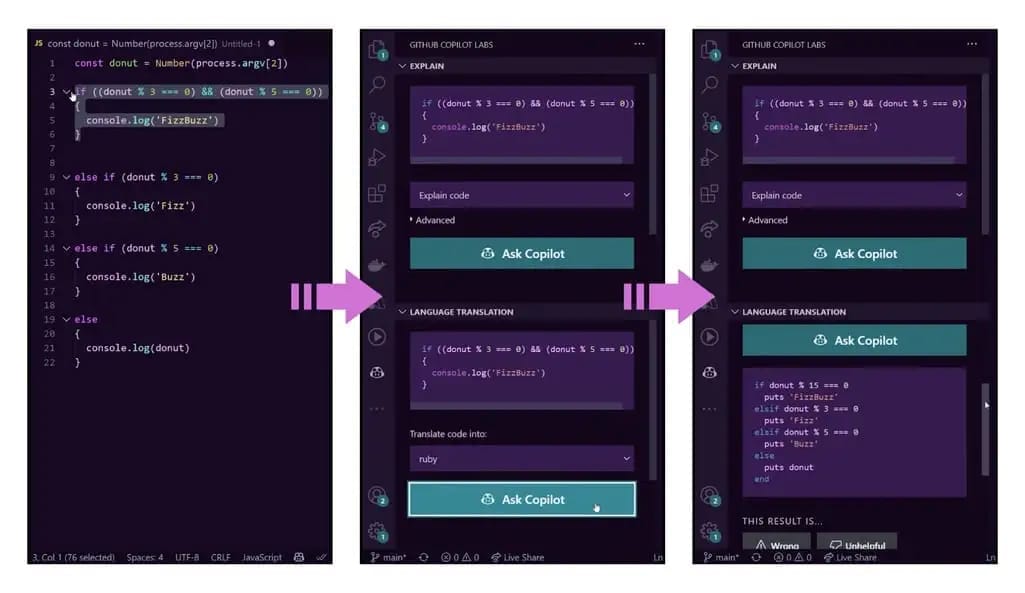
An example of code translation by Copilot Labs. Source: Dev.to
Pricing. Github Copilot offers a free plan that includes 50 agent mode or chat requests per month and 2,000 code completions per month. There is also a free subscription available to verified students and teachers. Paid plans for individuals start from $10/month, and for businesses–from $19/month per user. You can find details here.
Cursor: AI-native IDE that understands your entire codebase — and acts on it
Cursor is a standalone AI-native IDE based on Visual Studio Code. It is designed to be a drop-in replacement for VS Code but enhanced with deep AI capabilities out of the box.
Cursor is one of the tools developers at AltexSoft prefer. “This code editor understands your codebase, predicts your next edits, and allows you to edit code using natural language instructions. It gives users deep control and granulated features”, says Glib Zhebrakov, head of the Center of Engineering Excellence.
Language support. This AI coding tool supports a wide range of programming languages, with a strong focus on Python, JavaScript, and TypeScript. It also performs well with Swift, C, and Rust.
Integrations. Cursor includes built-in Git integration, supports extensions from the VS Code marketplace, and can interact with terminals, version control systems, and databases.
Functionality. The editor offers context-aware code suggestions after analyzing the entire project workspace, not just the open file. Besides standard features like autocompletion, editing, and translation, it automates unit test generation, bug detection, and fixing. Its special gifts also include suggesting multiple edits at once and predicting where you'll move your cursor next so that you can get really lazy.
There’s a feature that opens a prompt bar directly within the editor. Instead of writing a prompt in a chat sidebar or switching to a terminal, you press a shortcut and type right there in your file.
Cursor has an agentic mode that allows rapid prototyping. You type something like “build me a snake game” — and the AI generates the code, which, of course, needs multiple corrections and iterations, but still, you can build a simple app within hours, even if you are a complete novice in programming. This looks like a miracle and makes this tool a perfect choice for non-developers.
Pricing. It has three plans. Free for individuals (2000 completions per month), Pro (unlimited completions, $20/month) and Business ($40/user/month). Look for more details here.
Amazon Q Developer (CodeWhisperer): Adhering to security best practices
Amazon Q Developer (formerly Amazon CodeWhisperer) is an AI-powered coding tool primarily designed to provide real-time code recommendations for building applications tailored to run on AWS infrastructure. Q Developer uses LLMs trained on billions of lines of code.
Language support. Amazon Q Developer supports various programming languages, including Python, Java, JavaScript, TypeScript, C#, Rust, Go, Ruby, Scala, Kotlin, PHP, C, C++, Shell, and SQL. The languages with the most support for feature development are Java, Python, JavaScript, and TypeScript. Look for the detailed list here.
Integrations. In addition to VS Code, Visual Studio, and the JetBrains IDEs, Q Developer is compatible with AWS coding environments. Integration with Eclipse IDE is now available in a preview version. You can also use it via Command Line Interface (CLI), or chat with Q Developer in Microsoft Teams and Slack applications.
Functionality. Q Developer can scan code to identify issues as you write or perform on-demand scans of your entire project and suggest code improvements for swift remediation. Code recommendations, from single-line snippets to full functions, are generated automatically based on file contents or in response to natural language prompts.
One helpful feature is the automated generation and updating of documentation (README files).
The tool ensures the code aligns with the developer's style and naming conventions. Users can accept the top suggestion, explore more recommendations, or continue writing their own code.
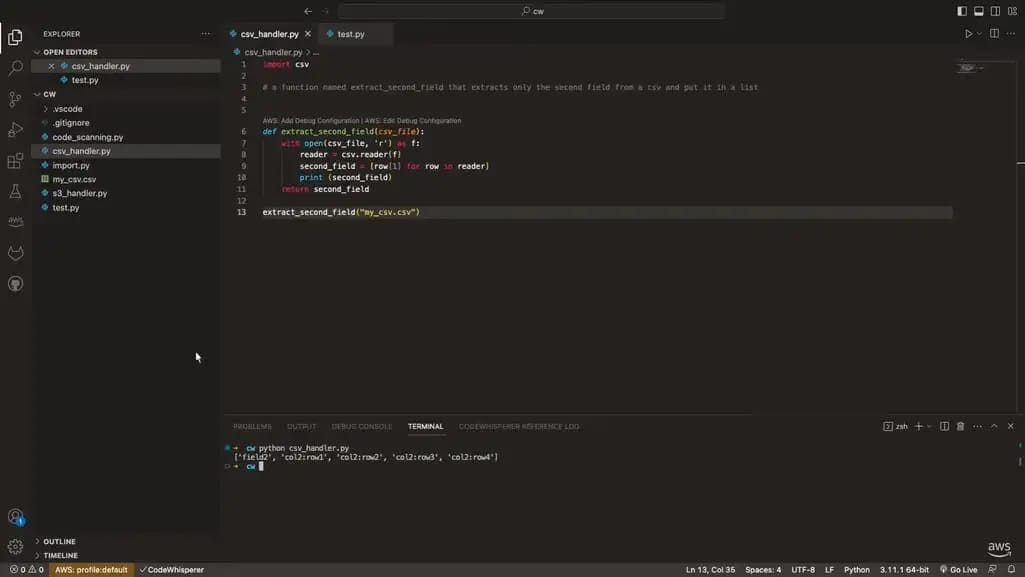
An example of Q Developer suggesting functions to extract the second field from a CSV file and return it in a list, with successful results in testing. Source: Amazon Web Services
Recommendations also align with best practices for addressing security vulnerabilities, such as those outlined by the Open Worldwide Application Security Project (OWASP) and similar security best practices.

Amazon states that it previewed Q Developer with a productivity challenge. The results were that participants using Q Developer completed tasks up to 80 percent faster on average than those who did not use it.
Pricing. A free Individual Tier plan allows you to generate code suggestions limited to 50 monthly chat interactions. You can also use it to develop software 5 times per month or transform up to 1,000 lines of code per month. The Professional Tier, priced at $19/month per user, extends to up to 500 code scans per user per month. To know more, check here.
Tabnine: Сredible LLMs for code completion and generation
Tabnine is designed to provide a comprehensive AI-assisted development workflow, supporting code creators from concept to completion.
Language support. Tabnine works with over 600 programming languages, libraries, and frameworks, with 20+ most supported, including JavaScript, TypeScript, Node.js, Java, Python, PHP, C++, Go, and Rust.
Integrations. The tool is compatible with Visual Studio 2022, VS Code, Eclipse, and JetBrains IDEs.
Functionality. Tabnine produces real-time contextual suggestions as you code, generates full function completion based on the function declaration, and transforms users' natural language prompts into code blocks. The tool combines universal knowledge with developers’ coding styles. You can easily generate comprehensive documentation for code blocks by clicking the “document” link above any function. Or you can give a prompt in the chat to create any documentation for the project.
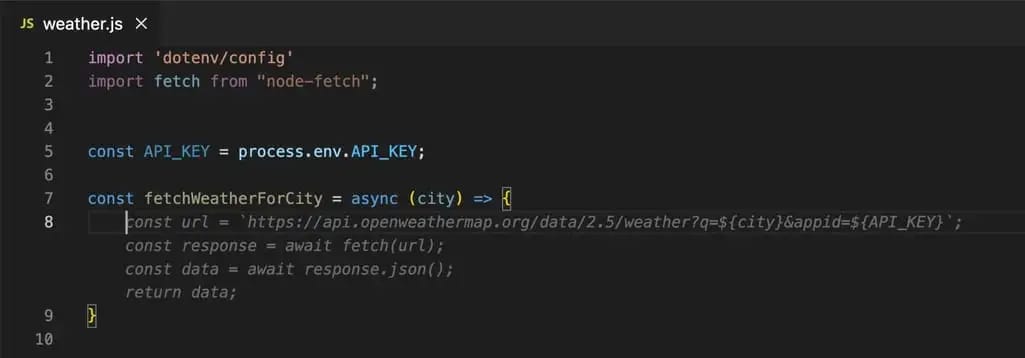
An example of a user typing a function signature and Tabnine suggesting a block of code. Source: Tabnine
Tabnine highlights that its code suggestions are based on LLMs exclusively trained on credible open-source code with permissive licensing. It also claims not to use customer code to train Tabnine's models.
Pricing. Tabnine provides a free 14-day or 30-day tier, depending on the plan. The paid plans start from $9/month per user. You can learn more here.
Windsurf: Security-first IDE-native AI coding assistant
Windsurf, formerly known as Codeium, is an AI coding tool developed by Exafunction. Currently, OpenAI is in talks to acquire Windsurft for $3 billion.
The product leverages advanced generative models and deep learning model-serving software. It comes in two variants: the older one is a set of plugins, and the new one, called the Windsurf Editor, is a standalone IDE powered by AI that can collaborate with you like a copilot and complete tasks independently.
It’s another instrument that AltexSoft engineers actively use. “Windsurf is a fantastic IDE that supports AI-driven autocompletion, inline editing, multi-file editing, chatting with your codebase, and agent workflows. It’s comparatively simple, intuitive, and has a polished UI”, - says Glib Zhebrakov from AltexSoft.
Language support. Windsurf has been trained on 70+ programming languages, including JavaScript, Python, TypeScript, PHP, Go, Java, C, C++, Rust, and Ruby.
Integrations. Plugins can be integrated with about 20 popular IDEs and web editors, such as VS Code, Colab, Neovim, and Jupyter Notebooks.
Functionality. Windsurf offers four standout features: Tab (Autocomplete), Command, Chat, and Cascade.
Prioritizing security, Windsurf Autocomplete uses proprietary generative models trained in-house. These models understand the context of the code and comments and generate suggestions on what users might want to type next. There is no dependency on open-source models or third-party APIs.
Command lets you open a command bar directly in the editor without switching to the chat or terminal.
Windsurf Chat generates, debugs, and explains code using a combination of its proprietary model and third-party OpenAI APIs. It can also translate entire functions from one programming language to another and perform code refactoring.
Cascade is an AI agent that understands what you're trying to do and can work with even the most complex codebases. It handles multistep edits across different files and lets you search the web or upload images—like wireframes or Figma mockups—to use as a reference. It’s currently available in the Windsurf Editor and JetBrains IDEs.
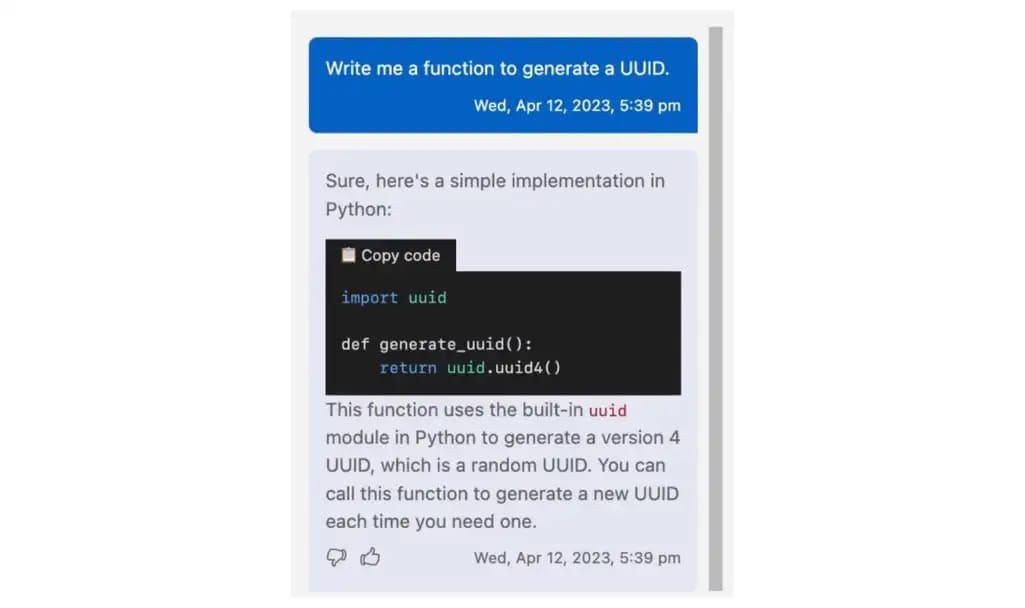
An example of Windsurf Chat answering a prompt asking to write a function to generate a UUID. Source: Windsurf Chat
Pricing. There is an Individual free plan that includes all fundamental features, but prompts are limited to 25 credits/month (which is equal to 100 GPT-4.1 prompts). The paid plan starts at $15/month. Look for more details here.
Replit: A browser-based IDE perfect for learning
Replit is a coding platform that blends coding and learning with AI assistance. There’s a mobile and desktop app as well.
Language Support. Replit supports over 80 programming languages, including Python, JavaScript, HTML/CSS, Java, C++, Go, and more. It’s especially popular for web development and scripting tasks, and its Ghostwriter AI is optimized for commonly used languages like Python and JavaScript.
Integrations. The product runs entirely in the browser, so there’s no need to install or configure an IDE. It integrates natively with GitHub.
Functionality. Replit’s Ghostwriter AI provides code completion, code generation, and natural language explanations. It also supports code refactoring, debugging help, and unit test generation. Ghostwriter has two modes, agentic and assistant.
But what really sets this tool apart is how beginner-friendly and collaborative it is. You can build apps with your phone. Everything is plug-and-play, since you don’t need to set up environments.
In addition to standard features, Replit offers structured, hands-on learning tracks like "100 Days of Code," plus guides and templates that make building skills as you go easy. The platform also encourages social learning through synchronous multiplayer coding in chat, shared projects, and a large, active user community.
Pricing. Replit has a limited free tier (3 development apps). The paid subscription starts at $20. You can find more details here.
ChatGPT: General-purpose solution with the ability to simplify coding
ChatGPT, created by OpenAI, is an LLM-based chatbot that understands and generates natural language text considering the input it receives. Comparing it to other AI coding tools is slightly like comparing apples to oranges: ChatGPT is a generalist that can code. But many developers still use it, so we decided not to ignore it.
Language support. ChatGPT can help with a wide range of programming languages, including JavaScript, Python, TypeScript, PHP, Go, Java, Kotlin, Swift, C, and C++. Additionally, it can assist with languages like Rust, Ruby, SQL, and Bash.
Integrations. You can install a ChatGPT extension to your development environment (e.g., CodeGPT for VS Code or EasyCode for JetBrains IDEs) or use OpenAI APIs.
In 2024, ChatGPT presented a new feature for macOS that allows direct code editing in IDEs like VS Code, Xcode, Terminal, and iTerm2 (macOS replacement for Terminal). No extension installation is required — it works with macOS system permissions.
Functionality. ChatGPT can suggest code snippets, variable and function names, and method calls based on the code the user has written so far. While it also generates code for the given task, the result will largely depend on the quality of text prompts you give.
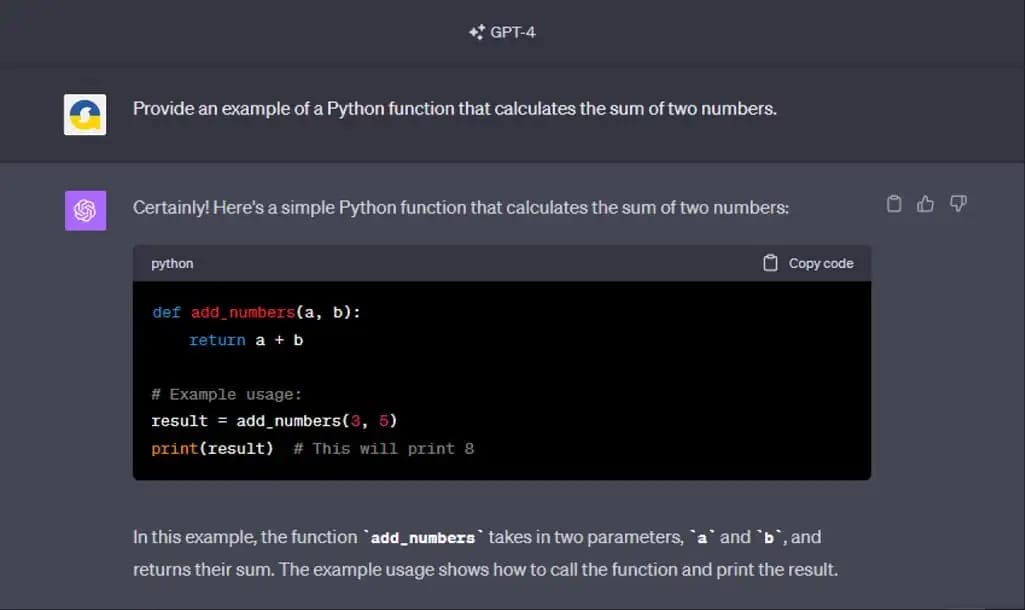
An example of ChatGPT generating code for a simple prompt asking to provide a Python function that calculates the sum of two numbers.
Besides that, ChatGPT reviews code for bugs and vulnerabilities, spotting syntax and logical errors, code style violations, and security issues. It compares the code against standard coding guidelines and provides suggestions for improvements.
ChatGPT can also convert a piece of code to other programming languages or explain its logic, functions, and overall structure. Additionally, the tool gives you a helping hand in code documentation, providing guidance on how to write clear and concise comments.
Pricing. GPT‑4o mini is available for free, and GPT-4o and o4-mini are also free with usage limits. Several paid plans are provided starting at $20/month; more details are here.
AI for coding: room for growth
AI coding tools offer significant benefits, including increased efficiency and productivity for developers, and ensure a reduced learning curve for newcomers to the field. However, it's important to remember that AI coding is still evolving, and a complete understanding of its potential and limitations may require several more years of exploration.
One crucial aspect to highlight is the necessity of reviewing code suggestions and responses created by AI coding tools. Despite the advancements in accuracy, AI coding outputs can still contain errors and require human intervention, especially in complex or critical tasks. Failure to review the AI's output can cause technical debt for your team.
Several factors influence the accuracy of AI coding tools, such as task complexity and the choice of programming language. The accuracy is higher for popular, widely used programming languages. Developers must assess and validate AI-generated code just like they would review code created by other specialists.
For example, Stack Overflow's moderators noticed an issue with inaccurate responses produced by ChatGPT. These responses, while appearing plausible on the surface, often turned out to be faulty. To prevent the platform from being flooded with incorrect AI-generated responses, StackOverflow banned answers generated by any LLM.
AI coding continues to evolve and is expected to provide greater accuracy in the coming years. As it advances, developers should continue to harness the power of AI while carefully assessing the quality and accuracy of the code generated.

